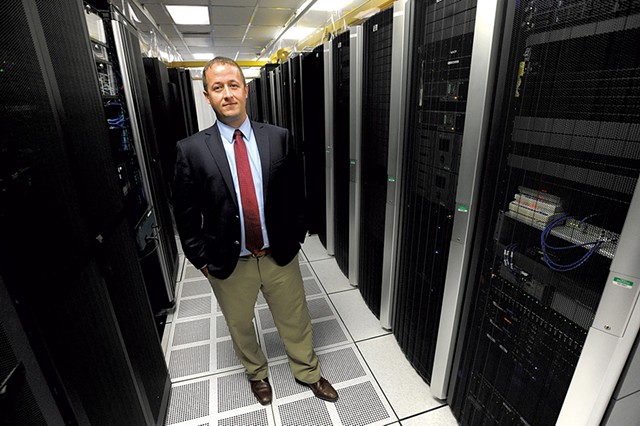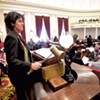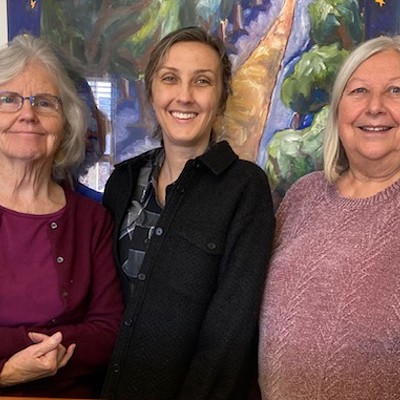Switch to the mobile version of this page.
Vermont's Independent Voice
- News
- Arts+Culture
- Home+Design
- Food
- Cannabis
- Music
- On Screen
- Events
- Jobs
- Obituaries
- Classifieds
- Personals
Browse News
Departments
-
News

Middlebury College President Patton to Step Down…
-
News

Overdose-Prevention Site Bill Advances in the Vermont…
-
Housing Crisis

'We're Leaving': Winooski's Bargain Real Estate Attracted…
- Aggressive Behavior, Increased Drug Use at Burlington's Downtown Library Prompt Calls for Help City 0
- An Act 250 Bill Would Fast-Track Approval of Downtown Housing While Protecting Natural Areas Environment 0
- Through Arts Such as Weaving, Older Vermonters Reflect on Their Lives and Losses This Old State 0
Browse Arts + Culture
View All
local resources
Browse Food + Drink
View All
Browse Cannabis
View All
-
Culture

'Cannasations' Podcaster Kris Brown Aims to 'Humanize'…
-
True 802

A Burlington Cannabis Shop Plans to Host…
-
Business

Judge Tosses Burlington Cannabiz Owner's Lawsuit
-
Health + Fitness

Vermont's Cannabis Nurse Hotline Answers Health Questions…
-
Business

Waterbury Couple Buy Rare Vermont Cannabis License
Browse Music
View All
Browse On Screen
Browse Events
Browse Classifieds
Browse Personals
-

If you're looking for "I Spys," dating or LTRs, this is your scene.
View Profiles
Special Reports
Pubs+More
New State Agency's Domain: Fixing Vermont's Tech Problems
Published June 21, 2017 at 10:00 a.m.
Earlier this year, Rep. Maida Townsend (D-South Burlington) asked officials at the Vermont Department of Information and Innovation what she thought was a simple question: "How many people do we have working on information technology in the state [government]?"
No one could give her an answer. "It boggled my mind," said Townsend.
Lawmakers have also unsuccessfully tried to find out how much the state spends on IT.
Since the arrival of the digital age, IT employees and resources have been scattered across more than two dozen state agencies and departments. As a result, the state lacks basic knowledge about its technology resources and has taken a haphazard approach to digital services that leaves the different IT fiefdoms duplicating one another's work.
Gov. Phil Scott's administration says it began addressing that issue in April, when the governor's executive order turned the small department that oversaw some but not all of the state's IT work into an all-encompassing Agency of Digital Services.
The newly created agency not only can quantify how many people work in IT, it has control over all 380 of them.
Vermont's legislature went along with Scott's proposal, but some lawmakers question whether the new agency will be anything more than a rebranded entity — another bureaucratic creation that won't improve the state's digital track record.
"I'm hoping this is not an exercise in rearranging deck chairs on the Titanic," Townsend said.
Computer technology is an increasingly essential and expensive tool of state government, but in recent years Vermont has bungled major IT projects, squandering millions of dollars and breeding doubts about the government's ability to manage complex initiatives that depend on a digital component.
Vermont Health Connect, the state's infamously flawed online health insurance exchange built by outside contractors, has cost $200 million so far. In 2012, the Vermont Judiciary had to abandon a $4.3 million court-case-management system. In 2010, the Department of Taxes unveiled a $6.3 million online platform that turned out to be dysfunctional. Starting in 2006, the Department of Motor Vehicles poured $18 million into a driver data system that it ultimately scrapped.
These high-profile flops have delayed other projects, leaving some state employees reliant on archaic technology. Employees at the Agency of Human Services, for example, are using 34-year-old software to determine who qualifies for food stamps.
The Department of Information and Innovation was created in 2003 to provide IT support to state employees and additional oversight of major projects. How much responsibility it has for the state's IT fiascos remains the subject of debate, but most officials agree that the department didn't have the authority to adequately monitor IT investments or to intervene when problems arose.
During its relatively brief existence, the tech department may have been the most maligned entity in state government. Legislators questioned the department's oversight, clashed with commissioner Richard Boes and periodically threatened to deprive it of funding. They were particularly affronted in 2015 when the department barred access on the state government network to online entertainment sites including Pandora and Netflix for legislators and state employees alike.
"DII has a terrible reputation amongst all of the other agencies," said Rep. Sam Young (D-Glover), a web developer in the private sector. That friction has been apparent for years, according to Young, and has hampered the department's already limited oversight role.
Not surprisingly, legislators didn't rush to the department's defense when Scott proposed replacing it with an Agency of Digital Services, a change he promised would result in "a more coordinated and accountable approach to managing the state's IT infrastructure."
While lawmakers rejected Scott's other attempts to reorganize government — he proposed merging the departments of labor and commerce and combining the Department of Liquor Control with the Vermont Lottery Commission — they got behind this one.
Legislators are hopeful, but they acknowledge the risk. A broader mandate means that the new agency's mistakes could reverberate more widely. Young's assessment: "It has the greatest potential for reward and failure."
One outside expert, John Burton, founder of the South Burlington technology management company NPI, praised the creation of a new agency and the elevation of its leader to a member of Scott's cabinet. That, he said, should bring more attention to the state's technology needs and result in a more coherent strategy to address them. In 2015, Burton served on a study committee convened by the legislature that recommended making this very move.
To fill the new post, Scott selected John Quinn, a 37-year-old Northfield native who has spent his entire career in state government. The former mid-level Department of Information and Innovation manager volunteered on the Republican governor's campaign last year and frequently tweeted messages defending him.
Quinn also worked closely with Scott to draw up the proposal for the agency he now oversees. He said his job is to "make sure we're on the right platforms to accomplish what the governor would like and what the legislature would like."
The digital services agency has swept up all IT staff across state government. Those employees will stay at their current physical locations and continue to provide services for the same departments, but they now work for Quinn.
Darwin Thompson, who served as interim Department of Information and Innovation commissioner after Scott chose not to reappoint Boes, has joined Quinn's leadership team. He's one of eight directors charged with overseeing IT operations at each state agency.
"Under the previous structure," Thompson said, "we were attempting to provide a common service across state government, but all these places had their own IT people that really weren't beholden through a chain of command."
The new agency will make it easier to collaborate by sharing expertise and resources, according to Quinn. One of his agency's first steps was to create an inventory of every piece of software used across state government. The total exceeds 1,000; one reason the number is so high, he said, is that a department will sometimes purchase new software without knowing that another part of state government already owns it. The next step, the secretary explained, will be to review all purchasing contracts to determine which ones can be consolidated.
Quinn said the agency is also calculating how much the state spends on IT; a rough estimate pegged the total number, including hardware, software and staff time, at $90 million a year.
Thompson offered another example of potential efficiencies under the new system: The Department of Information and Innovation had been purchasing hardware — computers, phones and such — for only three-quarters of the state's employees. "If we were purchasing for all state employees, we could drive the per-unit cost down," he said.
Dean Hamel used to direct IT services as an employee of the Department of Public Safety. Under the new arrangement, he remains in that department but reports directly to Quinn at the Agency of Digital Services. He is accountable, as well, to the commissioner of public safety — "John is technically my boss; the commissioner is the guy I serve," he said.
Since the transition, "I still sit in the same office, interact with the same people, oversee the same people and provide the same services," he said. The difference? "Relationships have improved across the agencies and departments ... We're not operating as autonomously as we used to do. We're sharing skill sets."
But putting everyone on a single organizational chart doesn't ensure they'll get along, and officials can't impose a collaborative culture on employees scattered across state offices in dozens of locations.
Quinn discounts the geographic challenge. "Technology has evolved to the point where I can click a button on the computer and have a chat messenger window pop up and be able to talk to the person back and forth like they're sitting here," he noted.
Quinn and his directors do acknowledge that they haven't convinced all of their employees of the merits of a new structure. "I think we're maybe split into two camps — those that think it's a good idea and those that are maybe not so optimistic," said Thompson.
A state-employed software developer said his colleagues are approaching the transition with "cautious ambivalence."
"If there's one central bottleneck through which all things have to go, that could hold us back," noted the developer, who requested anonymity because he wasn't authorized to speak to the press.
Dan Smith, an independent technology consultant hired by the legislature, raised a similar concern back in April. He told lawmakers that when a single agency assumes complete responsibility for IT operations, it risks becoming an "agency of no." In other words, it could be overly cautious, second-guessing crucial projects.
Smith concluded that the agency could bring efficiencies but said the administration hadn't shown how it would do a better job monitoring major projects.
The governor's people won support for the new structure by making assurances that state workers wouldn't lose their jobs. "I am not firing anyone," confirmed Quinn. But will a new agency composed and led by former Department of Information staffers actually do anything differently than its bureaucratic predecessor?
Rep. Young is skeptical. "How much new expertise have they brought in for the new agency?" he asked.
Boes, the former Department of Information commissioner, thinks the conversion from department to agency could be an improvement, noting that states with centralized technology services tend to have better track records. But, he cautioned, "None of this is easy under any type of structure." To execute the transition, he said, "You need a strong leadership team."
Does he think Quinn is capable? "I'm going to stay silent on that subject. I don't think it's appropriate for someone who is no longer with the administration to second-guess someone who is doing that job today," said Boes.
After graduating from Champlain College with a degree in computer networking and PC support, Quinn landed a temporary job in 2001 as an IT specialist at the Department of Buildings and General Services. He worked his way up during the past decade and a half; when Scott tapped him, he was a manager in the Department of Information overseeing 15 people who made up the enterprise applications group.
Managing 380 people is vastly different than overseeing 15, but Quinn insists he's the right person for the job.
"I know a lot of these people already. I know their styles. I've worked with a lot of them over the years," he said. He's also participated in consolidation efforts that brought almost all state employees into the same email system and reduced the number of data centers — where the state stores its servers — from 11 to four.
According to Rep. Townsend, lawmakers will be watching Quinn closely. They have demanded that the agency deliver a detailed implementation plan, updated information about how the transition affects employees and state finances, and regular progress reports.
"If those pieces weren't in place, my hair would be on fire," Townsend said.
Correction, June 21, 2017: An earlier version of this story misstated the current number of state government data centers.
Got something to say?
Send a letter to the editor
and we'll publish your feedback in print!
More By This Author
About The Author

Alicia Freese
Bio:
Alicia Freese was a Seven Days staff writer from 2014 through 2018.
Alicia Freese was a Seven Days staff writer from 2014 through 2018.
Speaking of...
-

Burlington Is Storing Critical Computer Hardware in Decrepit Memorial Auditorium
Jun 15, 2022 -

Painful Lessons From the Past Inform Labor Department’s $30M Computer Overhaul
Oct 20, 2021 -

Mainframe of Shame: The IT Failure That Crashed Vermont's Unemployment System
Apr 22, 2020 -

House Votes to Hike Minimum Wage — But Not as Quickly as the Senate Would
May 15, 2019 -

Vermont House Committee Plans Rare Closed-Door Meeting
Mar 12, 2019 - More »
Comments (3)
Showing 1-3 of 3
Comments are closed.
From 2014-2020, Seven Days allowed readers to comment on all stories posted on our website. While we've appreciated the suggestions and insights, right now Seven Days is prioritizing our core mission — producing high-quality, responsible local journalism — over moderating online debates between readers.
To criticize, correct or praise our reporting, please send us a letter to the editor or send us a tip. We’ll check it out and report the results.
Online comments may return when we have better tech tools for managing them. Thanks for reading.
- 1. 'We're Leaving': Winooski's Bargain Real Estate Attracted a Diverse Group of Residents for Years. Now They're Being Squeezed Out. Housing Crisis
- 2. Middlebury College President Patton to Step Down in December News
- 3. Aggressive Behavior, Increased Drug Use at Burlington's Downtown Library Prompt Calls for Help City
- 4. Through Arts Such as Weaving, Older Vermonters Reflect on Their Lives and Losses This Old State
- 5. Overdose-Prevention Site Bill Advances in the Vermont Senate News
- 6. High School Snowboarder's Nonprofit Pitch Wins Her Free Tuition at UVM True 802
- 7. Help Seven Days Report on Rural Vermont 7D Promo
- 1. Totally Transfixed: A Rare Eclipse on a Bluebird Day Dazzled Crowds in Northern Vermont 2024 Solar Eclipse
- 2. Zoie Saunders, Gov. Scott’s Pick for Education Secretary, Faces Questions About Her Qualifications Education
- 3. Don't Trash Those Solar Eclipse Glasses! Groups Collect Them to Be Reused 2024 Solar Eclipse
- 4. State Will Build Secure Juvenile Treatment Center in Vergennes News
- 5. Vermont Awarded $62 Million in Federal Solar Incentives News
- 6. New Jersey Earthquake Is Felt in Vermont News
- 7. Barre to Sell Two Parking Lots for $1 to Housing Developer Housing Crisis





































